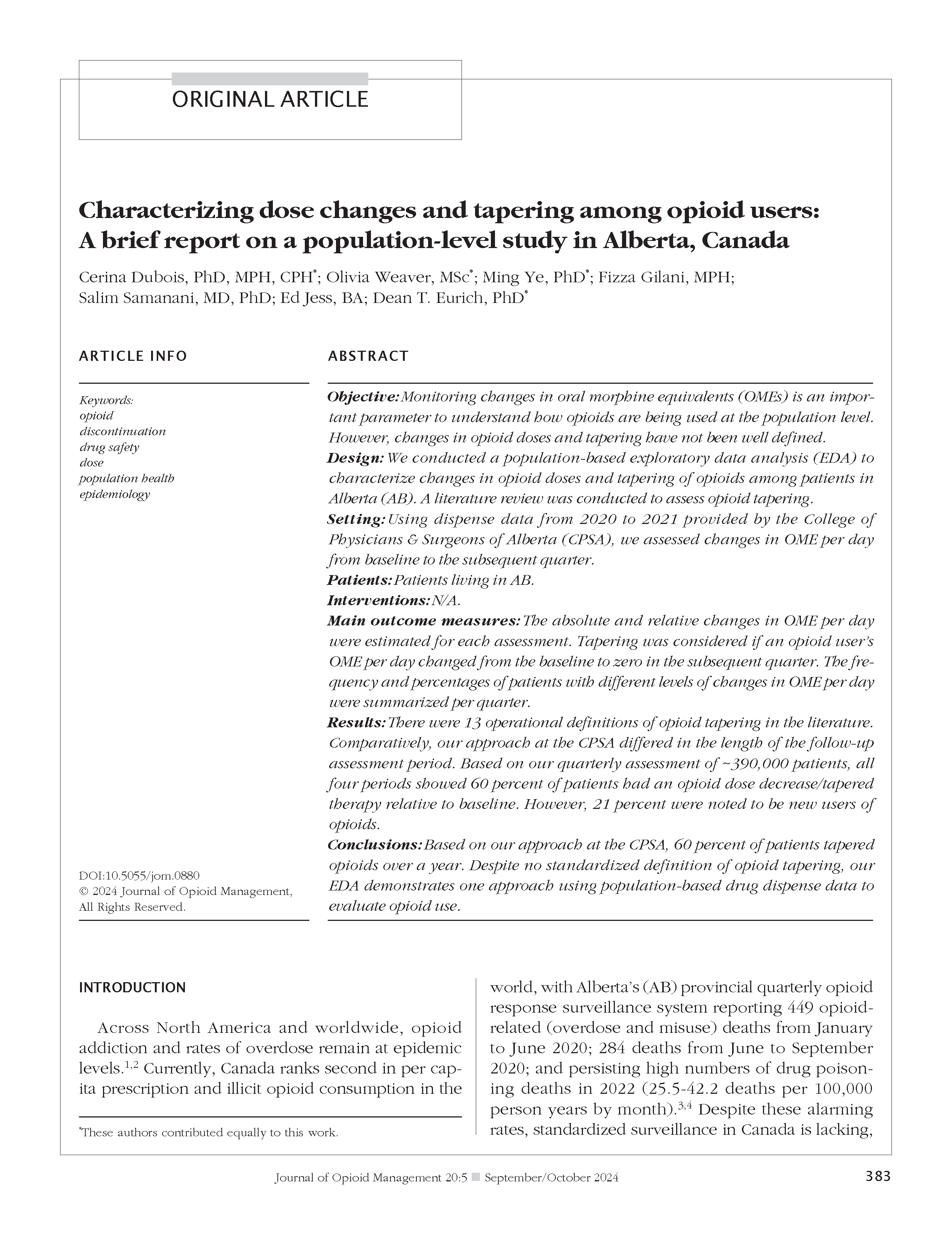Characterizing dose changes and tapering among opioid users: A brief report on a population-level study in Alberta, Canada
DOI:
https://doi.org/10.5055/jom.0880Keywords:
opioid, discontinuation, drug safety, dose, population health, epidemiologyAbstract
Objective:Monitoring changes in oral morphine equivalents (OMEs) is an important parameter to understand how opioids are being used at the population level. However, changes in opioid doses and tapering have not been well defined.
Design:We conducted a population-based exploratory data analysis (EDA) to characterize changes in opioid doses and tapering of opioids among patients in Alberta (AB). A literature review was conducted to assess opioid tapering.
Setting:Using dispense data from 2020 to 2021 provided by the College of Physicians & Surgeons of Alberta (CPSA), we assessed changes in OME per day from baseline to the subsequent quarter.
Patients:Patients living in AB.
Interventions:N/A.
Main outcome measures:The absolute and relative changes in OME per day were estimated for each assessment. Tapering was considered if an opioid user's OME per day changed from the baseline to zero in the subsequent quarter. The frequency and percentages of patients with different levels of changes in OME per day were summarized per quarter.
Results:There were 13 operational definitions of opioid tapering in the literature. Comparatively, our approach at the CPSA differed in the length of the follow-up assessment period. Based on our quarterly assessment of ~390,000 patients, all four periods showed 60 percent of patients had an opioid dose decrease/tapered therapy relative to baseline. However, 21 percent were noted to be new users of opioids.
Conclusions:Based on our approach at the CPSA, 60 percent of patients tapered opioids over a year. Despite no standardized definition of opioid tapering, our EDA demonstrates one approach using population-based drug dispense data to evaluate opioid use.
References
Azadfard M, Huecker MR, Leaming JM: Opioid Addiction. Florida: StatPearls, 2023.
(CDC) CfDCaP: Understanding the opioid overdose epidemic. 2023. Available at https://www.cdc.gov/opioids/basics/epidemic.html. Accessed May 6, 2024.
Alberta Go: Alberta: Quarterly opioid surveillance report. Accessed at https://open.alberta.ca/dataset/f4b74c38-88cb-41ed-aa6f-32db93c7c391/resource/e8c44bab-900a-4af4-905a-8b3ef84ebe5f/download/health-alberta-covid-19-opioid-responsesurveillance-report-2020-q2.pdf. Accessed January 8, 2022.
Moe J, Camargo CA, Jelinski S, et al.: Epidemiologic trends in substance and opioid misuse-related emergency department visits in Alberta: A cross-sectional time-series analysis. Can J Public Health. 2018; 109(2): 164-173. DOI: 10.17269/s41997-018-0053-6. DOI: https://doi.org/10.17269/s41997-018-0053-6
Hooten WM: Opioid management: Initiating, monitoring, and tapering. Phys Med Rehabil Clin N Am. 2020; 31(2): 265-277. DOI: 10.1016/j.pmr.2020.01.006. DOI: https://doi.org/10.1016/j.pmr.2020.01.006
Matthias MS: Opioid tapering and the patient–provider relationship. J Gen Intern Med. 2020; 35(1): 8-9. DOI: 10.1007/s11606-019-05337-4. DOI: https://doi.org/10.1007/s11606-019-05337-4
Pergolizzi JV, Varrassi G, Paladini A, et al.: Stopping or decreasing opioid therapy in patients on chronic opioid therapy. Pain Ther. 2019; 8(2): 163-176. DOI: 10.1007/s40122-019-00135-6. DOI: https://doi.org/10.1007/s40122-019-00135-6
Minegishi T, Garrido MM, Stein M, et al.: Opioid discontinuation among patients receiving high-dose long-term opioid therapy in the veterans health administration. J Gen Intern Med. 2020; 35(Suppl. 3): 903-909. DOI: 10.1007/s11606-020-06252-9. DOI: https://doi.org/10.1007/s11606-020-06252-9
Larochelle M, Lagisetty PA, Bohnert ASB: Opioid tapering practices-time for reconsideration? JAMA. 2021; 326(5): 388-389. DOI: 10.1001/jama.2021.11118. DOI: https://doi.org/10.1001/jama.2021.11118
Program TATP: TPP Alberta. Available at https://www.tppalberta.ca/. Accessed January 10, 2024.
CPSA: Standards of practice: Safe prescribing for OUD. 2023. Available at https://cpsa.ca/wp-content/uploads/2023/02/Safe-Prescribing-for-OUD.pdf. Accessed January 12, 2024.
Information CIfH: Opioid prescribing in Canada: How are practices changing? 2019. Available at https://www.cihi.ca/sites/default/files/document/opioid-prescribing-canada-trends-enweb.pdf. Accessed January 10, 2024.
Mazurenko O, Gupta S, Blackburn J, et al.: Long-term opioid therapy tapering: Trends from 2014 to 2018 in a Midwestern state. Drug Alcohol Depend. 2021; 228: 109108. DOI: 10.1016/j.drugalcdep.2021.109108. DOI: https://doi.org/10.1016/j.drugalcdep.2021.109108
Larochelle MR, Lodi S, Yan S, et al.: Comparative effectiveness of opioid tapering or abrupt discontinuation vs no dosage change for opioid overdose or suicide for patients receiving stable long-term opioid therapy. JAMA Netw Open. 2022; 5(8): e2226523. DOI: 10.1001/jamanetworkopen.2022.26523. DOI: https://doi.org/10.1001/jamanetworkopen.2022.26523
Morrow RL, Bassett K, Wright JM, et al.: Influence of opioid prescribing standards on drug use among patients with long-term opioid use: A longitudinal cohort study. CMAJ Open. 2019; 7(3): E484-E491. DOI: 10.9778/cmajo.20190003. DOI: https://doi.org/10.9778/cmajo.20190003
Zhou K, Jia P, Bhargava S, et al.: Opioid tapering in patients with prescription opioid use disorder: A retrospective study. Scand J Pain. 2017; 17: 167-173. DOI: 10.1016/j.sjpain.2017.09.005. DOI: https://doi.org/10.1016/j.sjpain.2017.09.005
Agnoli A, Xing G, Tancredi DJ, et al.: Association of dose tapering with overdose or mental health crisis among patients prescribed long-term opioids. JAMA. 2021; 326(5): 411-419. DOI: 10.1001/jama.2021.11013. DOI: https://doi.org/10.1001/jama.2021.11013
Fenton JJ, Agnoli AL, Xing G, et al.: Trends and rapidity of dose tapering among patients prescribed long-term opioid therapy, 2008-2017. JAMA Netw Open. 2019; 2(11): e1916271. DOI: 10.1001/jamanetworkopen.2019.16271. DOI: https://doi.org/10.1001/jamanetworkopen.2019.16271
Fenton JJ, Magnan EM, Agnoli AL, et al.: Longitudinal dose trajectory among patients tapering long-term opioids. Pain Med. 2021; 22(7): 1660-1668. DOI: 10.1093/pm/pnaa470. DOI: https://doi.org/10.1093/pm/pnaa470
Perez HR, Buonora M, Cunningham CO, et al.: Opioid taper is associated with subsequent termination of care: A retrospective cohort study. J Gen Intern Med. 2020; 35(1): 36-42. DOI: 10.1007/s11606-019-05227-9. DOI: https://doi.org/10.1007/s11606-019-05227-9
Ds M, Boudreau D, Ichikawa L, et al.; Primary care opioid taper plans are associated with sustained opioid dose reduction. J Gen Intern Med. 2020; 35(3): 687-695. DOI: 10.1007/s11606-019-05445-1. DOI: https://doi.org/10.1007/s11606-019-05445-1
Mark TL, Parish W: Opioid medication discontinuation and risk of adverse opioid-related health care events. J Subst Abuse Treat. 2019; 103: 58-63. DOI: 10.1016/j.jsat.2019.05.001. DOI: https://doi.org/10.1016/j.jsat.2019.05.001
Oliva EM, Bowe T, Manhapra A, et al.: Associations between stopping prescriptions for opioids, length of opioid treatment, and overdose or suicide deaths in US veterans: Observational evaluation. BMJ. 2020; 368: M283. DOI: 10.1136/bmj.m283. DOI: https://doi.org/10.1136/bmj.m283
Martin BC, Fan MY, Edlund MJ, et al.: Long-term chronic opioid therapy discontinuation rates from the TROUP study. J Gen Intern Med. 2011; 26(12): 1450-1457. DOI: 10.1007/s11606-011-1771-0. DOI: https://doi.org/10.1007/s11606-011-1771-0
Jivraj NK, Scales DC, Gomes T, et al.: Evaluation of opioid discontinuation after non-orthopaedic surgery among chronic opioid users: A population-based cohort study. Br J Anaesth. 2020; 124(3): 281-291. DOI: 10.1016/j.bja.2019.12.006. DOI: https://doi.org/10.1016/j.bja.2019.12.006
Berna C, Kulich RJ, Rathmell JP: Tapering long-term opioid therapy in chronic noncancer pain: Evidence and recommendations for everyday practice. Mayo Clin Proc. 2015; 90(6): 828-842. DOI: 10.1016/j.mayocp.2015.04.003. DOI: https://doi.org/10.1016/j.mayocp.2015.04.003

Published
How to Cite
Issue
Section
License
Copyright 2005-2025, Weston Medical Publishing, LLC and Journal of Opioid Management. All Rights Reserved.










